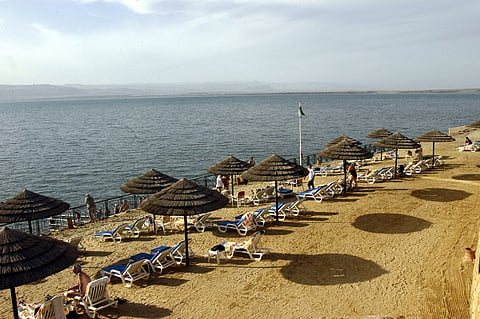
- Locations
- Interviews
- Luxury Home
- Luxury Lifestyle
- Luxury Travel
- Events
- More
- Magazine
- Contact
- Media Kit

By Janis Turk
Seducing travelers with tingling waters and salt-encrusted cliffs like clear rock candy, the Dead Sea has long beckoned vagabonds, Bedouins, Crusaders and kings—and even mere Everyman travelers like me.
Along the highway that cuts through the Jordan Valley, the Dead Sea emerges as a welcome mirage—a cerulean oasis in a brittle, parchment-paper-colored wilderness. Bordered by the bleak desert mountains and pale valleys of Palestine, Israel and Jordan, the world's deepest hypersaline lake is legendary in size and story. Lying 430 meters below sea level, and reaching a depth of 701 meters, the "Salt Sea" rests close to the ancient cities of Jerusalem and Amman and not far from the lost horizon of legendary Petra and wind-swept Arabian Deserts.

For happy wanderers like me, the Dead Sea's allure is not just the sweet sting of salt on my skin or some sexy sunbathing scene; and it's not the water's oft-lauded health and beauty benefits, either. Rather it is the tony resort hotels that spoon its salty banks and its close proximity to the ancient treasures of art, history and culture that lures me to the lowest place on the planet.
Float Like a Butterfly
The Dead Sea contains the highest salt concentration of any other body of water, so swimmers float effortlessly in a seated or standing position, enabling them to read a newspaper without getting it wet. That makes a fun Instagram photo, but even more fun are the posh pool and spa areas of the local resorts on both the Jordanian and the Israeli sides. With lush gardens, tented cabanas and posh outdoor lounge spaces, infinity-edge pools that blend into the blue horizon, outdoor fire pits, intimate spa tubs under the stars, private beaches and shady al fresco dining spots, hotels at the Dead Sea are luxurious retreats. For the first day or two I explore the resorts, but after enjoying a Dead Sea mud scrub and a dip in the salty waters, I feel relaxed, prune-like and pretty—ready to explore the secrets of Jordan and Israel beyond these briny banks.

I like to think of the Dead Sea as my own discovery, but of course it's been a spa playground for kings and commoners since the beginning of time. Even Hollywood royalty Brad Pitt and Angelina Jolie have stayed here.
Biblical proportions
In Old Testament days, King David hid from his enemies in caves near the Dead Sea. More than 900 years later, King Herod the Great built a palace and fortress overlooking the western shore on Mount Masada.
Today the ruins of Herod's reign are not only a popular tourist attraction with a museum at its base and cable car to the top, but such vestiges of history also the setting for a 7,5000-stadium seat amphitheater where the Israeli Opera Festival hosts performances each summer. Next year's festival (June 2015) toasts "Tosca" and "Carmina Burana." With Masada as a dramatic backdrop, it's as though the ghosts of two millenniums join in a spectral chorus. Twice weekly, April through October, the amphitheater also offers a nighttime light show that brings to life the history of Masada.

Ninety miles from Masada, the ancient walled city of Jerusalem sprawls, a marketplace of myriad wonders—its gilded Dome of the Rock gleaming in the sun and stone streets teaming with rivalling cultures, histories and commerce. There, on summer evenings, the story of Jerusalem also unfolds in a colossal sound and light multi-media "Night Spectacular" at the Citadel at the Tower of David.
Petra by Night
Across the Dead Sea in Jordan, the ancient rose-colored sandstone ruins of ancient Petra are illuminated by 1,500 candles on Mondays, Wednesdays and Thursdays nights each summer—and it's just as spectacular by day. A UNESCO World Heritage site since 1985, Petra, is one of the world's most famous historic archeological sites, an architecturally astounding city of towering edifices hewn into cliffs. Dating early as 312 BCE, today it is Jordan's most-visited tourist attraction and rates among the top 7 Man-Made Wonders-of-the-World.
Caravan
South of Petra, the Wadi Rum area was the setting of the adventures of T. E. "Lawrence of Arabia" and is still home Bedouin encampments where travelers can ride camels and sleep in tents. Set far off road on the way to the Red Sea city of Aqaba is the Feynan Eco Lodge, an idyllic "green" candle-lit lodge resting in the antediluvian deserts of the Wadi Feynan valley. About a 45-minute drive from the Dead Sea resorts, travelers also enjoy the Evason Ma'in Hot Springs resort: an oasis of waterfalls and steaming hot springs. Ancient Roman ruins litter the yellow-flower-dotted fields of Jeresh near Amman. Throughout the region, shops, galleries, churches and museums showcase the intricate mosaics and colorful hand-thrown pottery of local artisans.

Drop-Dead Sea Beauty
With the Arabian nights magic of moon-scape-like deserts, it's no wonder travelers love this area. Yes, the hot, shadows-less lands surrounding the Dead Sea have the savage beauty of a big chalky gravel pit; but, in their midst, raw splendor emerges. There, sapphire waters glisten like a gemstone found half-buried in the sand—a reminder that, even in lowly places, something astonishing may appear.
